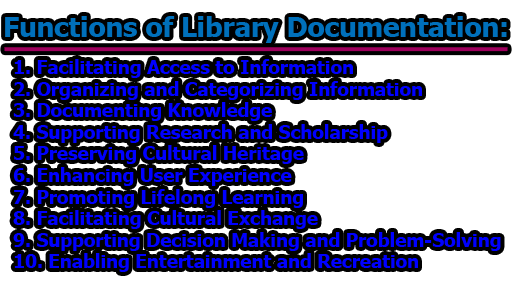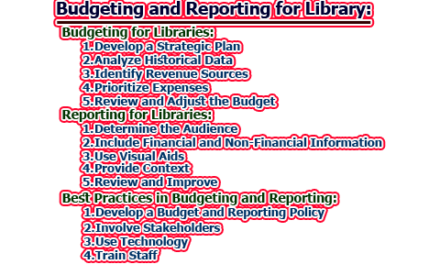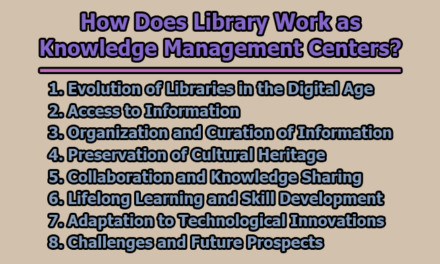Library Documentation:
Library documentation stands at the core of the information ecosystem, serving as a gateway to the vast reservoirs of human knowledge and cultural heritage. It encompasses a diverse array of resources, from traditional books and catalogs to cutting-edge digital repositories and databases. As custodians of information, libraries play a pivotal role in organizing, preserving, and disseminating this wealth of knowledge to diverse user communities. Library documentation enables seamless access to relevant information, supports scholarly research and education, and fosters a culture of lifelong learning. In this article, we will explore the concepts, nature, types, and functions of library documentation, exploring its significance in the digital age and the evolving landscape of information services.
Concepts of Library Documentation:
Library documentation embodies a set of fundamental principles and practices designed to effectively manage, organize, and disseminate information within library settings. Its core concepts revolve around systematic information organization, metadata creation, and user-centricity. Through cataloging and indexing, library documentation ensures the logical arrangement of resources, allowing users to locate materials efficiently based on various attributes. By creating comprehensive metadata, librarians enable accurate search and retrieval systems, facilitating seamless access to a diverse array of resources. Additionally, the user-centric approach emphasizes understanding and meeting the information needs of patrons, enhancing the overall user experience and promoting inclusive access to knowledge.
Nature of Library Documentation:
The nature of library documentation is characterized by its dynamic and multifaceted attributes. It encompasses a wide range of resources, including traditional and digital formats, underscoring adaptability to technological changes. Library documentation plays a pivotal role in preserving and transmitting knowledge across generations, safeguarding cultural heritage, and supporting lifelong learning. Collaboration and resource sharing among libraries further amplify the reach and scope of documentation efforts, fostering intellectual freedom and information democratization. As libraries embrace digital transformation, the nature of documentation reflects an ongoing commitment to making knowledge accessible to all, reinforcing the educational mission and relevance of libraries in the global information landscape.
Types of Library Documentation:
Library documentation encompasses a diverse range of materials and resources that serve various purposes in organizing, accessing, and disseminating information. These types of documentation play a crucial role in the functioning of libraries and their ability to support research, education, and the dissemination of knowledge. Here are the key types of library documentation:
A. Catalogs: Library catalogs are comprehensive lists of all the materials available in a library’s collection. These can be in print or digital formats and provide detailed records for each item, including books, journals, audiovisual materials, e-books, and more. Catalogs help users find specific items and understand the scope of a library’s holdings.
B. Indexes: Indexes are tools that enable users to locate information within specific resources, such as books, journals, or magazines. They list keywords or subjects along with the corresponding page numbers where those terms can be found within the source material. Indexes are valuable for researchers and scholars looking to locate specific information within lengthy documents.
C. Abstracts: Abstracts are concise summaries of longer documents, such as research papers, articles, or conference proceedings. They provide an overview of the content, allowing users to quickly assess whether the full document is relevant to their research or interests. Abstracts are particularly useful for researchers seeking to identify relevant literature efficiently.
D. Bibliographies: Bibliographies are lists of books, articles, and other materials related to a particular subject or field of study. They serve as valuable resources for researchers, guiding them to authoritative sources on specific topics. Annotated bibliographies provide additional information, such as brief summaries or evaluations of each resource.
E. Manuals and Guides: Library documentation includes manuals and guides that explain how to use specific resources or navigate the library’s services effectively. User guides for library databases, search tools, and reference materials assist patrons in accessing and utilizing information resources efficiently.
F. Subject Headings: Subject headings are standardized terms used to describe the content of resources. They aid in the organization and retrieval of information by providing a consistent and controlled vocabulary for cataloging. Subject headings facilitate subject-based searches, enabling users to explore materials related to specific topics.
G. Databases: Databases are collections of structured information that can be searched, retrieved, and manipulated. Libraries maintain databases containing a wide variety of resources, including articles, images, audio, video, and more. Database management ensures users can access relevant and up-to-date information within their fields of interest.
H. Digital Libraries: Digital libraries are online repositories of digitized materials, including books, manuscripts, photographs, and multimedia content. These resources can be accessed remotely, expanding the reach of the library’s collection. Digital libraries are particularly valuable for preserving and providing access to rare or fragile materials.
I. Theses and Dissertations: Many academic libraries maintain collections of theses and dissertations submitted by students. These documents showcase original research conducted by students pursuing advanced degrees. Theses and dissertations contribute to the dissemination of academic knowledge and support research in various disciplines.
J. Archival Collections: Archival collections consist of historical documents, records, manuscripts, and ephemeral materials that hold cultural, social, and historical significance. These materials are often preserved in specialized archives within libraries, providing researchers and scholars with valuable primary sources for historical research.
K. Government Documents: Government documents include publications issued by government agencies at the local, national, or international level. Libraries often maintain collections of government documents that provide valuable information on public policies, legislation, statistical data, and official reports.
L. Maps and Atlases: Libraries may house collections of maps, atlases, and geographic resources that support research in geography, history, urban planning, and environmental studies. These resources provide valuable visual representations of geographical information.
M. Multimedia Resources: Library documentation encompasses a wide variety of multimedia resources, including audio recordings, videos, films, and visual artworks. These materials contribute to the enrichment of academic and recreational pursuits.
N. Special Collections: Special collections consist of unique or rare materials that require special care and attention. These may include antiquarian books, manuscripts, artifacts, and works of art. Special collections often support research and educational initiatives in specific subject areas or historical periods.
O. Ephemeral Materials: Ephemeral materials are printed or digital resources designed for short-term use or distribution, such as brochures, pamphlets, posters, and newsletters. Libraries may collect and preserve ephemeral materials that document current events, cultural trends, or historical moments.
Functions of Library Documentation:
Library documentation serves several essential functions that contribute to the effective functioning of libraries and the dissemination of knowledge to users. These functions encompass various aspects, from facilitating access to information to supporting research and education. Let’s explore the functions of library documentation in brief:
- Facilitating Access to Information: One of the primary functions of library documentation is to provide users with easy and efficient access to information. By creating catalogs, indexes, and databases, librarians organize materials in a structured manner, making it simpler for patrons to locate resources based on subject, author, title, or other attributes. User-friendly search interfaces enhance the information retrieval process, ensuring that users can find the materials they need quickly.
- Organizing and Categorizing Information: Library documentation involves systematic information organization, ensuring that resources are arranged in a logical and coherent manner. Through classification systems and subject headings, librarians categorize materials into distinct subject areas, making it easier for users to browse and identify relevant resources. This organization facilitates serendipitous discovery and encourages the exploration of related topics.
- Documenting Knowledge: Library documentation plays a crucial role in documenting human knowledge and cultural heritage. By collecting, cataloging, and preserving various resources, including books, journals, manuscripts, and digital materials, libraries become repositories of intellectual and historical achievements. This function contributes to the preservation of cultural heritage and the continuity of human understanding across generations.
- Supporting Research and Scholarship: Academic and research libraries leverage library documentation to support scholarly activities. Through access to scholarly journals, academic databases, and research papers, libraries provide researchers with valuable resources for their studies and investigations. Documentation tools such as abstracts and indexes aid researchers in locating relevant literature and navigating vast bodies of knowledge.
- Preserving Cultural Heritage: Library documentation extends beyond providing access to knowledge; it also involves preserving and conserving cultural heritage. Special collections and archives within libraries house rare books, manuscripts, historical documents, and other valuable resources that contribute to understanding the history, traditions, and values of different societies.
- Enhancing User Experience: Library documentation contributes to enhancing the overall user experience. By providing clear and accurate metadata, relevant search results, and personalized recommendations, librarians strive to meet the diverse information needs and preferences of library patrons. Documentation practices, such as user guides and training materials, empower users to navigate library resources effectively and independently.
- Promoting Lifelong Learning: Library documentation fosters a culture of lifelong learning by offering resources and services that support self-education and intellectual growth. Libraries serve as hubs of knowledge, providing access to a wide range of materials on diverse topics, encouraging users to explore new interests and acquire new skills throughout their lives.
- Facilitating Cultural Exchange: Library documentation plays a significant role in facilitating cultural exchange and understanding. By providing access to resources from various cultures, languages, and perspectives, libraries promote diversity and inclusivity, fostering a global community of informed and engaged citizens.
- Supporting Decision-Making and Problem-Solving: Library documentation assists users in making informed decisions and solving problems. By providing authoritative and reliable information, libraries empower individuals, professionals, and policymakers to access the knowledge they need to address challenges and make well-informed choices.
- Enabling Entertainment and Recreation: Beyond academic and research purposes, library documentation supports leisure reading and entertainment. Libraries curate a vast collection of fiction, multimedia resources, and recreational materials, offering patrons an escape into imaginative worlds and fostering a love for reading and learning beyond academic pursuits.
In conclusion, library documentation plays a foundational and indispensable role in the efficient functioning of libraries and the dissemination of knowledge. From catalogs and indexes to digital libraries and archival collections, these diverse types of documentation facilitate seamless access to information and support various academic, research, and recreational pursuits. Through meticulous organization, metadata creation, and preservation efforts, libraries become repositories of human knowledge and cultural heritage, contributing to the continuity of understanding across generations. The user-centric approach in library documentation enhances the overall patron experience, empowering users to navigate vast resources with ease and discover new insights. As libraries adapt to technological advancements and changing user demands, the significance of library documentation remains unwavering, bridging the gap between information seekers and valuable resources, fostering a culture of lifelong learning, and promoting intellectual exploration within the global community.
FAQs:
What is library documentation?
Library documentation refers to a comprehensive set of principles, practices, and resources used by libraries to organize, catalog, and provide access to a diverse range of information and knowledge. It encompasses various types of materials, from physical books to digital resources, and plays a crucial role in supporting research, education, and cultural preservation.
What are the main types of library documentation?
The main types of library documentation include catalogs, indexes, abstracts, bibliographies, manuals, guides, subject headings, databases, digital libraries, theses and dissertations, archival collections, maps and atlases, government documents, multimedia resources, special collections, and ephemeral materials.
How does library documentation support research and scholarship?
Library documentation provides researchers and scholars with access to a wide range of academic databases, journals, and research papers. Abstracts and indexes aid in locating relevant literature efficiently, while bibliographies guide users to authoritative sources on specific topics, supporting in-depth research and scholarly endeavors.
Why is metadata creation important in library documentation?
Metadata creation involves describing resources with essential details, such as author names, titles, and subject keywords. It serves as a crucial foundation for efficient search and retrieval systems, enabling users to find specific materials quickly and accurately.
How does library documentation contribute to preserving cultural heritage?
Library documentation, particularly in special collections and archives, houses rare books, manuscripts, historical documents, and cultural artifacts. By employing preservation and conservation strategies, libraries safeguard these valuable resources, contributing to the preservation of cultural heritage and historical understanding.
What is the role of digital libraries in library documentation?
Digital libraries are online repositories of digitized materials, expanding the accessibility and reach of library resources. They provide remote access to users, preserving rare and fragile materials, and embracing technological advancements to meet the demands of the digital age.
How does library documentation promote lifelong learning?
Library documentation offers a vast collection of resources on diverse topics, fostering a culture of continuous learning and personal growth. Users can access materials for self-education and skill development, supporting lifelong learning pursuits.
How do libraries use special collections in their documentation efforts?
Special collections contain unique or rare materials that require special care and attention. These collections support research in specific subject areas or historical periods, providing researchers and scholars with valuable primary sources and specialized resources.
How can library documentation enhance the user experience?
Library documentation ensures user-friendly search interfaces, personalized recommendations, and clear guides that empower patrons to navigate library resources effectively. A user-centric approach improves the overall user experience, making information discovery seamless and enjoyable.
What are the future trends in library documentation?
The future of library documentation involves continued integration of digital technologies, greater emphasis on open access and collaboration, enhanced user personalization, and adaptive documentation practices to cater to evolving user needs and technological advancements.

Assistant Teacher at Zinzira Pir Mohammad Pilot School and College










